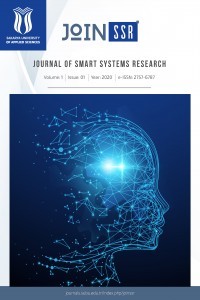Conceptual Design of a Novel Roadable Flying Car
Conceptual Design of a Novel Roadable Flying Car
eVTOL, aircraft, urban air mobility, engineering design,
___
- Vegh, JM, Botero, E., Clark, M., Smart, J. ve Alonso, JJ (2019, Ağustos). eVTOL uçak tasarımı ve analizi için NDARC ve SUAVE'nin mevcut yetenekleri ve zorlukları. Gelen 2019 AIAA / IEEE Elektrik uçak Teknolojileri Sempozyumu (yer) (s. 1-19). IEEE.
- Fredericks, W. L., Sripad, S., Bower, G. C., & Viswanathan, V. (2018). Performance metrics required of next-generation batteries to electrify vertical takeoff and landing (VTOL) aircraft. ACS Energy Letters, 3(12), 2989-2994.
- Audi, Italdesign and Airbus combine self-driving car and passenger drone, Audi MediaCenter, Mart 6, 2018
- https://www.mgm-compro.com/other-products/electric-motors/
- Ekinci, O. A., (2013), “Akıllı Taşıt Sistemlerinde Trafik Akışının Çoklu Ajan Yaklaşımıyla Büyük Ölçekte Benzetimi”, Yüksek Lisans Tezi, İTÜ Fen Bilimleri Enstitüsü.
- Utlu Z., Yenigün M. 2016. Elektrikli Araçlarda Kullanılan Soğutma Sistemlerinin Enerji Ve Ekserji Verimliliği Açısından İncelenmesi. Yüksek Lisans Tezi, İ.A.Ü. Fen Bilimleri Enstitüsü, İstanbul
- https://www.uavnavigation.com/company/blog/uav-navigation-depth-flight-envelope/
- Cavcar, A., (1997), "Hava Trafik Akış Yönetimi ve Hava Sahası Kapasitesi Analizi", Osmangazi Üniversitesi, Doktora Tezi, Eskişehir
- https://www.kirpart.com.tr/tr/cozumler/detay/Gelecek-Teknolojilerimiz/221/1654/0/
- Mejri, Mohamed Nidhal, Jalel Ben-Othman, Mohamed Hamdi. "Survey on VANET security challenges and possible cryptographic solutions". Vehicular Communications 1.2 (2014): 1-11.
- Söğüt, E. & Erdem, A., (2017), Günümüzün Vazgeçilmez Sistemleri: Nesnelerin Haberleşmesi ve Kullanılan Teknolojiler.
- Gökozan, H., Taştan, M., Sarı, A., (2017), “Smart Cities and Management Strategies”, International Strategic Research Congress (ISRC2017), Antalya
- Başlangıç: 2020
- Yayıncı: Sakarya Uygulamalı Bilimler Üniversitesi
Conceptual Design of a Novel Roadable Flying Car
Haktan YAĞMUR, Can BAYAR, Tunahan FİLİZ, Bedirhan ERTATLIGÜL, Kasım SERBEST
Hamid ASADİ DERESHGİ, Hüseyin DAL, Dilan DEMİR, Necip Furkan TÜRE
Holografik Görüntülerde Kenar Tabanlı Fraktal Özniteliklerin Hücre Canlılık Analizlerinde Başarısı
Muhammed Ali PALA, Murat Erhan ÇİMEN, Mustafa Zahid YILDIZ, Gamze GÜNEY ESKİLER, Asuman DEVECİ ÖZKAN
Navigasyon Sistemleri Çalışma Prensiplerinin Geometrik Tasarımı Üzerine
A Kinematic Design and Analysis of a Robotic Multi Motion Drive Machine
